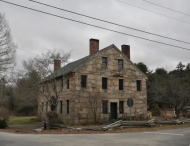Mill Record Killingly
RETURN TO ‘FIND MILLS’Disclaimer: Content for these properties was compiled in 2014-2017 from a variety of sources and is subject to change. Updates are occasionally made under Property Information, however the Connecticut Trust for Historic Preservation (dba Preservation Connecticut) makes no representation or warranty that the information is complete or up-to-date.
- Historic Information
Use (Historic)
Largest Documented Workforce
n/a
Historic Narrative
The stone dam on the Five Mile River survives on the east side of Stone Road, as does a granite house on the west side. The specific location of the archaeological ruins is restricted. For historical significance see National Register application: http://pdfhost.focus.nps.gov/docs/NRHP/Text/78002861.pdf
- Architectural Information
Number of Existing Buildings
one
Dates of Construction
n/a
Architect
n/a
Builder
n/a
Building Type
Architectural Description
Excerpt from HistoricDistrictsCT.org web site: General description: Stone Road, approximately one mile in length, is a thru-street connection Putnam Road and North Road. Currently, the unimproved road is lined with many mature trees and scattered stone walls. The condition of such walls vary along the length of the road. Daniels's Village is on the National Register of Historic places as an archaeological site, as most of what remains from the village are archaeological remains. Stone Road's historical importance is evident by reviewing the development that has occurred within the area throughout history. The road has been maintained and is still utilized today, providing historical continuity of the Daniel's Village. Significance of the property: Daniel's village contains a well preserved 19th century mill village archeological site. According to research presented by Albert Bartovics, the portions of the road date back to c. 1714. This portion of Stone Road was constructed to connect Putnam Heights (Killingly Hill) with the meeting house. The second phase of the road was cut circa 1744. The purpose of the road was to provide access from the newly constructed relocated grist mill to the original 1714 portion of Stone Road. Development within the village dates back to the mid 1720's, at which time the grist mill, one of the earliest developed in Killingly was constructed. Between the mid 1700's to the early 1800's, the village began to grow (a grist mill and dam- c. 1774, the saw mill - c, 1760, the cider-press, c. 1770; a tan yard and bark house, c. 1775). Most of the development of the village occurred after the Killingly Manufacturing Company established operation at the site in 1814. By 1825 two operational mills existed at the site, one of which was the fourth largest mills in Killingly, and one of the first Cotton Mills in Connecticut. In 1845, after the property was purchased by the Daniel's family, the village became known as Daniel's Village. In 1861, the factory building burned and thus marked the decline of the village.
Exterior Material(s)
n/a
Structural System(s)
n/a
Roof Form
n/a
Roof Material
n/a
Power Source
n/a
Condition
n/a
Condition Notes
Archaeological remains
- Property Information
-
Specific Location
Located in the vicinity of Stone Rd. near the crossing of Putnam Road and the Five Mile River.
Adjacent To
n/a
Exterior Visible from Public Road?
Yes
Parcel ID / Assessor Record Link
Acreage
n/a
Use (Present)
- Sources
-
Form Completed By
n/a
Date
n/a
Bibliography
- Representative View(s)Click on image to view full file




